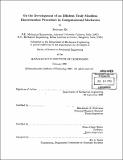| dc.contributor.advisor | Mandayam A. Srinivasan and Klaus-Jürgen Bathe. | en_US |
| dc.contributor.author | De, Suvranu, 1970- | en_US |
| dc.contributor.other | Massachusetts Institute of Technology. Dept. of Mechanical Engineering. | en_US |
| dc.date.accessioned | 2005-08-23T15:56:40Z | |
| dc.date.available | 2005-08-23T15:56:40Z | |
| dc.date.copyright | 2001 | en_US |
| dc.date.issued | 2001 | en_US |
| dc.identifier.uri | http://hdl.handle.net/1721.1/8865 | |
| dc.description | Thesis (Sc.D.)--Massachusetts Institute of Technology, Dept. of Mechanical Engineering, 2001. | en_US |
| dc.description | Includes bibliographical references (leaves 157-163). | en_US |
| dc.description.abstract | The objective of this thesis is to present an efficient and reliable meshless computational technique - the method of finite spheres - for the solution of boundary value problems on complex domains. This method is truly meshless in the sense that the approximation spaces are generated and the numerical integration is performed without a mesh. While the theory behind meshless techniques is rather straightforward, the generation of a computationally efficient scheme is quite difficult. Computational efficiency may be achieved by proper choice of the interpolation functions, effective ways of incorporating the essential boundary conditions and efficient and specialized numerical integration rules. The pure displacement formulation is observed to exhibit volumetric "locking" during incompressible (or nearly incompressible) analysis. A displacement/pressure mixed formulation is developed to overcome this problem. The stability and optimality of the mixed formulation are tested using numerical inf-sup tests for a variety of discretization schemes. Solutions to several example problems are presented showing the application of the method of finite spheres to problems in solid and fluid mechanics. A very specialized application of the technique to physically based real time medical simulations in multimodal virtual environments is also presented. In the current form of implementation, the method of finite spheres is about five times slower than the finite element techniques for problems in two-dimensional elastostatics. | en_US |
| dc.description.statementofresponsibility | by Suvranu De. | en_US |
| dc.format.extent | 163 leaves | en_US |
| dc.format.extent | 10824090 bytes | |
| dc.format.extent | 10823847 bytes | |
| dc.format.mimetype | application/pdf | |
| dc.format.mimetype | application/pdf | |
| dc.language.iso | eng | en_US |
| dc.publisher | Massachusetts Institute of Technology | en_US |
| dc.rights | M.I.T. theses are protected by copyright. They may be viewed from this source for any purpose, but reproduction or distribution in any format is prohibited without written permission. See provided URL for inquiries about permission. | en_US |
| dc.rights.uri | http://dspace.mit.edu/handle/1721.1/7582 | |
| dc.subject | Mechanical Engineering. | en_US |
| dc.title | On the development of an efficient truly meshless discretization procedure in computational mechanics | en_US |
| dc.type | Thesis | en_US |
| dc.description.degree | Sc.D. | en_US |
| dc.contributor.department | Massachusetts Institute of Technology. Department of Mechanical Engineering | |
| dc.identifier.oclc | 48749530 | en_US |
